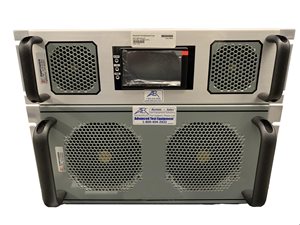Ask us about
test equipment solutions for your industry
Solid State vs. Traveling Wave Tube – How to Choose the Right Amplifier
You may not think you need to do much preliminary research before selecting an amplifier. There is a lot of transparency and educational supplements from manufacturers that explain what each product can do, empowering you to make an educated choice. However, if you are going to run varying tests with a single amplifier, you may need to dig a little more into the exact type of amp you need. Each one has a maximum level of efficiency, power storage, and testing speed – all of which are described by their amplifier type. To make the best selection possible, you should know exactly how much power output your testing requires. While there is a wide variety of amplifiers to choose from, today's blog is going to focus on the difference between TWT and Solid State Power Amplifiers, as well as some of the variants for those amplifiers. Keep reading this blog to learn more about each amplifier's use cases!
Within these two categories, amplifiers can be further divided into equipment for more specific applications. Here are a few examples of amplifiers that can be built as TWT or SSP.
 industrial applications.
industrial applications.
An example of a Broadband/Wideband Amplifier is the Empwer 2180 Solid State Broadband High Power Amplifier | 1 GHz - 2.5 GHz, 200W.
 amplifiers, but are also used in audio and lab equipment.
amplifiers, but are also used in audio and lab equipment.
An example of a Linear Amplifier is the AE Techron 9110 Amplifier.

An example of an RF Power Amplifier is the Advanced Amplifiers AA-80M1G-300 Solid State Amplifier.
To learn more about amplifiers and which type might suit you best, please feel free to reach out to us directly at 800-404-2832.
TWT Amplifier
Traveling Wave Tubes Amplifiers (TWTAs) were once heavily relied upon for amplification, but have been somewhat outpaced by newer amplifier structures like Solid State Power Amps (SSPAs). Even though they aren’t the latest in amplifier tech, TWT amps still offer durability throughout a long operating lifetime. They even serve as the backbone of other amplifier systems – they are the basis for broadband amps, which are built on helix TWT devices. TWT amps, despite their age, are still capable of higher output-power densities than solid-state amps, so they are useful in applications that require a wider range for testing. TWT amplifiers are most viable for medium to high-power applications, where a wide bandwidth is necessary.Solid State Power Amplifier
Though they were developed around nearly the same time, solid state amplifiers (SSAs) are often considered to be “newer” technology than TWTAs. SSPAs began making the leap into relevancy with innovations like silicon bipolar transistors and gallium arsenide transistors devices, to present-day amplifiers that are based on some aspect of SSPA technology, like GaN transistors and integrated circuits. SSPAs are best for applications that are not wide band and require less power. Because they do not need the same high voltage a TWT amplifier does, technicians with less experience operating amplifiers can successfully use an SSPA. Solid State Power Amplifiers commonly serve the defense and aerospace markets.Within these two categories, amplifiers can be further divided into equipment for more specific applications. Here are a few examples of amplifiers that can be built as TWT or SSP.
Broadband/Wideband Amplifiers
Broadband amplifiers provide RF amplification in wideband settings. They operate by reproducing a wide range of signals, without suffering a significant loss throughout the pass band. Typically, these amps range in frequency from 2-18 GHz, and are ideal for defense, radar, telecommunications, and other industrial applications.
industrial applications.An example of a Broadband/Wideband Amplifier is the Empwer 2180 Solid State Broadband High Power Amplifier | 1 GHz - 2.5 GHz, 200W.
Linear Amplifier
A linear amplifier is defined as an electrical circuit with an output that is directly proportional to its input. These amplifiers are capable of delivering a greater amount of power into a load, but variables like load impedance, input base current, output capacity, and supply voltage can all impact the efficiency of the amp. Linear amplifiers can sometimes be classified as RF (radio frequency) amplifiers, but are also used in audio and lab equipment.
amplifiers, but are also used in audio and lab equipment.An example of a Linear Amplifier is the AE Techron 9110 Amplifier.
RF Power Amplifier
Radio frequency power amplifiers are able to convert a low-power RF signal into a high-power signal. They perform by driving the antenna of a transmitter, driving to another high-power source, and exciting microwave cavity resonators. Reputable models of RF transmitters will typically include functions such as power output, bandwidth, gain, linearity, input and output impedance matching, power efficiency, and heat dissipation. These amplifier units are often used for voice and data communication, and sometimes weather sensing.
An example of an RF Power Amplifier is the Advanced Amplifiers AA-80M1G-300 Solid State Amplifier.
So which is better?
Even though there is a perception of TWTAs being surpassed by SSPAs in terms of advancements, TWTAs are still useful and relevant to today's testing. Designers are even finding ways to combine TWTAs high output power density with smaller, more compact design, helping newer models rival the compact circuitry of SSPAs. They way engineers and designers are constructing equipment is adaptive, and what’s old may one day become new again.To learn more about amplifiers and which type might suit you best, please feel free to reach out to us directly at 800-404-2832.
Posted August 22, 2025
